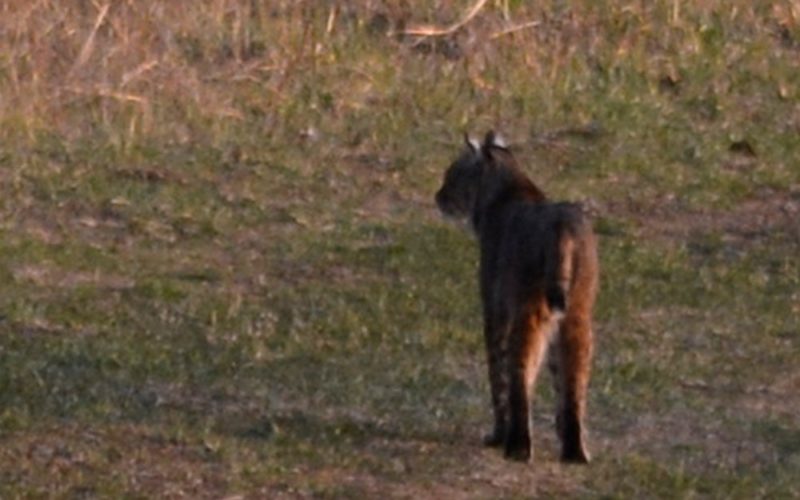Tips make encounters with predators safer
AMANDA BANCROFT
Making Ripples
Encounters with predators are extremely rare, and attacks or injuries even rarer. However, if you enjoy outdoor recreation, carry with you the knowledge of how to handle predator encounters more safely. It could save the day — or your life! Even though you could go a lifetime without seeing one, you could come face-to-face with predators such as the bobcat, coyote, black bear, grey fox, red fox, wolf or even a cougar passing through the area. It doesn’t matter if you only stay in urban areas; there is still a risk.
Stay off your cell phone as much as possible when out walking or hiking, because an alert person is a safer person. Pick up small children or small dogs if you spot a predator nearby. It also helps to carry an umbrella or walking stick, whistle or noise-maker. Not every predator requires the same response. Use different tactics depending on the species.
Dogs form packs in our area, and some individuals can be quite large. The Centers for Disease Control recommends that we remain still, do not make eye contact, keep our bodies turned to the side rather than facing the dog from the front, and slowly back away with our hands formed into fists held near our throat, elbows in. Eye contact may make a dog more aggressive.
Coyotes are a different story. Maintain eye contact and don’t turn your back on coyotes. If coyotes are nearby, but minding their own business, ignore them and be aware of their movements. But if they come close, stalk, growl, or stare at you, take action. This saves the coyote’s life as well as yours or your dog’s or child’s. Unafraid coyotes are dead coyotes, eventually shot when they consistently approach humans. Don’t run; you may trigger their instinct to chase you. Try to look big, shout or throw something in their direction. If one coyote is closer than the others, it’s probably the leader. Face them and do jumping jacks while yelling, or wave around an open umbrella. They may initially run a short distance away and look back; repeat the performance.
According to the Arkansas Game and Fish Commission, the native red wolves have been extinct in the Arkansas wild and exist elsewhere in low numbers. People who report seeing wolves are usually seeing coyotes that may carry the bloodline of wolves or domestic dogs. Regardless, behave in the same manner you would with coyotes.
Foxes are less likely to be problematic. The red fox is adapting to urban environments, and some see humans as wallpaper. Grey foxes aren’t even true foxes, and they are smaller than the red fox. Foxes don’t typically pose a threat to humans unless they’re sick or trying to defend a den. If the fox approaches you aggressively, respond the same way you would to coyotes.
Cougars may or may not have a breeding population in Arkansas. If a cougar acts like you’re prey, do the following: Look big, create loud noises, don’t make sudden movements, never turn your back on a cougar, and don’t bend down even to tie a shoe. Never run. Back away slowly and give the mountain lion plenty of room to escape. If it attacks anyway, fight back fiercely with any weapon you have, and aim for its eyes, throat and head.
Bobcats are much smaller than mountain lions and less likely to view humans as prey. If a bobcat does attack, it may be sick. The same strategy for cougar encounters applies to bobcats, too. You’re more likely to never see a bobcat than to be injured by one.
Black bears require different treatment based on context. If you spot cubs, and their mother is approaching you, play dead. You’ll have a better chance of survival. If no cubs are present, be loud, wave your arms, never run and back away slowly in the direction you came from. Research what type of spray to use if you desire that route; some sprays attract the bears rather than repel them. Black bears may be active at any time of day or night. The same goes for animals considered nocturnal – just because you see one at dawn, dusk or in the daytime doesn’t mean the animal is sick. The reverse is also true. Coyotes are diurnal or crepuscular but have adapted to nighttime activity in cities. They’re still seen in city parks in the middle of the day, though!
Walking dogs, especially on long leads or without a leash, is a magnet for predators. Most encounters happen when a dog is involved, and the tips listed here have been shown in various studies to be less effective at scaring away predators during dog walks. Be extra cautious when walking dogs in urban or rural areas known to have predators. One final thought: Remember that prey animals are not docile. Because moose are known to be aggressive towards humans, I’d rather encounter a coyote than a moose!
Amanda Bancroft is a writer, artist and naturalist living in an off-grid tiny house on Kessler Mountain. She and her husband Ryan blog about their adventures and offer tips to those wanting to make a difference at www.RipplesBlog.org.










